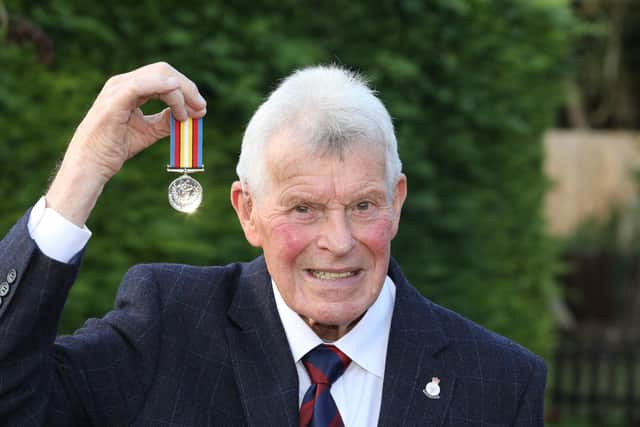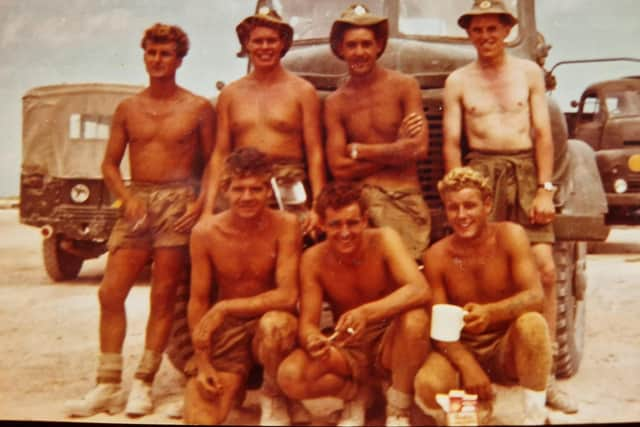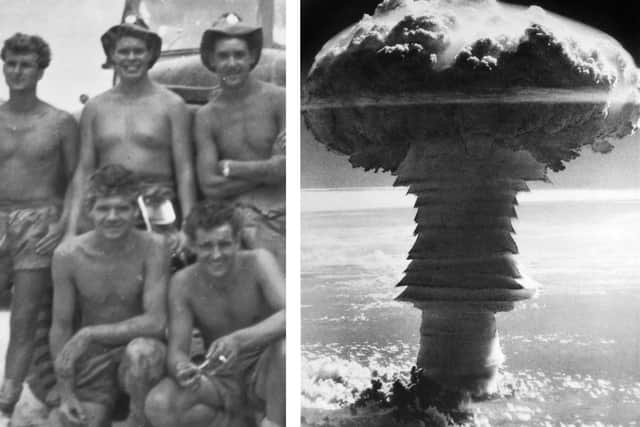Finedon nuclear test veteran and human 'guinea pig' to wear new medal at Remembrance Sunday service
and live on Freeview channel 276
A Finedon man who felt he was used as a human guinea pig after being exposed to three nuclear bombs whilst serving in the British Army in the 1950s has received a medal for his service.
Opting to sign up as a soldier instead of National Service seemed like the better option for John Goodjohn – then a teenager – as a way to see the world, earn a trade and get paid.
Advertisement
Hide AdAdvertisement
Hide AdBut little did he realise that he and his mates would be forced to watch the most powerful and destructive force devised by humankind – with only an overall and their hands for protection.


Great-grandfather Mr Goodjohn has now received the Nuclear Test Medal that recognises those who ‘participated’ in the UK’s nuclear testing programme across the world.
He said: “I just consider I’m lucky to be here at 85. I feel I was used as a guinea pig – we all were.”
As a teenager Mr Goodjohn joined the Royal Engineers for three years, first being posted to Germany, but after his troop was disbanded he and his friends were shipped out to warmer climes.
Advertisement
Hide AdAdvertisement
Hide AdStarting out on New Year’s Day in 1958, he was one of the 1,000 troops taken from Southampton aboard troop ship Dunera heading for Christmas Island, now Kiritimati.


A fan of hot weather, Mr Goodjohn enjoyed stop offs at Curacao and Panama but news of the nuclear testing programme had reached them via forces newspaper of choice Reveille.
Mr Goodjohn said: “We were taken to Christmas Island but we had read articles in the Reveille about Australians involved in the nuclear tests, saying it was ruining men’s ‘performance’.”
The first nuclear bomb Mr Goodjohn witnessed was not long after they arrived – the ‘Grapple Y’ test on April 28 – the first of Operation Grapple during which nine nuclear explosions were carried out.
Advertisement
Hide AdAdvertisement
Hide AdHe said: “We were assembled next to the main camp and we were given white boiler suits and a kind of cloth to cover our heads. They told us to face away from the blast and to cover our eyes with the balls of our thumbs.


“We were sat there and the tannoy was saying there were two Valiant bombers, one had the bomb the other didn’t. The tannoy was saying how many seconds there were to go. They told us when the bomb was going to be released. We were there and we were disciplined.”
When the bomb went off, the troops covered their eyes as ordered, but could still ‘see’ the intense blast and feel heat from the explosion, followed by the shock wave.
Describing what it was like, he said: “Imagine you walk out of the shade into the sun. The light is miles too bright to look at. Brighter than the sun. Then when we were told we could look, we could see the mushroom cloud was starting to form. We were eight to ten miles away. Afterwards we went to different parts of the island and all the birds’ feathers were singed.”
Advertisement
Hide AdAdvertisement
Hide AdMr Goodjohn, a lance corporal, and his friends were told that the wind would take any dangerous radiation away from their location and into the Pacific Ocean.
It wasn’t until years later as a member of a Christmas Island veterans’ group that he realised many of his friends were dying of cancer, a legacy he believes to be of the nuclear testing.
This Remembrance Sunday, Mr Goodjohn will wear his Nuclear Test Medal and veteran badge for the first time along with other military, civilian and overseas staff and personnel who participated in Britain’s nuclear testing programme in the 1950s and 1960s.
Mr Goodjohn said: “The veterans have been pushing for this medal. I’m just glad to be here. I feel like a survivor.”
Advertisement
Hide AdAdvertisement
Hide AdHe added there were many happy memories. He said: “The weather was fantastic and there was always tonnes of beer at night.”
The design of the medal features an atom surrounded by olive branches and bears the words ‘Nuclear Test Medal’ – the other side has an effigy of King Charles. The ribbon design includes white, yellow, black and red, with the lighter blue for the sky and ocean, representative of the Pacific.
Eligible veterans, civilians and their next of kin can now submit an application to the MOD Medal Office https://www.gov.uk/government/publications/applying-for-medals.